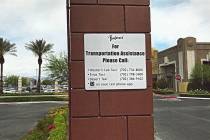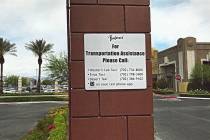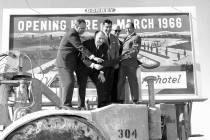Voters will get fourth try to support appellate court
Nevada voters pooh-poohed the idea of a Court of Appeals three times, but advocates have high hopes a fourth try in 2014 will succeed with a boost from a $400,000 campaign.
For the first time, a political action committee is raising money for a television and radio campaign to advocate for a court that would decide certain cases on appeal and leave the big stuff to the Nevada Supreme Court.
Logic tells me the idea is a good one, but voters haven’t seen it my way, rejecting the idea in 1972, 1988 and 2010. The last time, it was up at the same time as a question to appoint judges instead of electing them. Many believe that was the appellate court’s downfall.
“In 2010, we made a mistake in assuming the legal community understood the need and, most importantly, how it will operate,” Justice James Hardesty said.
That won’t happen this time. Since August, advocates for an appeals court, including justices, legislators and state Bar officials have been making presentations to law firms and officials about how an appellate court will be a time saver that will make the courts more efficient, result in speedier justice, and clear up backlogs of pending cases.
State Bar President Alan Lefebvre, one of the forces behind the effort who explained the nuts and bolts to me, said the campaign’s “appeal has to be to the people’s sense of good government.”
That’s classy, but I disagree. To succeed, an ad campaign, must answer this question for voters: “What’s in it for me?”
Hardesty provided plenty of examples, explaining nearly everyone is touched by the courts, directly or indirectly.
He cited a child custody case involving children 3 and 5. By the time it reached the state Supreme Court, the children were 7 and 9.
“That translates into a very real delay into their lives and their parents’ lives, and it’s a direct result of the caseload the court has.”
Prisoners in custody seeking a new trial wait longer, so do crime victims wanting resolution.
Sometimes, it’s not the parties in the case who are impacted, he said. Taxi drivers should want to know whether the minimum wage laws apply to them, one of the cases the court recently heard, even if they are not in the case. Teachers should care about whether their email addresses are public or private.
The Nevadans for a Court of Appeals PAC has raised about $75,000. The PAC is co-chaired by two state senators and lawyers who are philosophical opposites: Democrat Tick Segerblom and Republican Greg Brower. Obviously, the question is not divided by any partisanship.
Nevada is one of only 10 states without a court of appeals, and it’s the state with the largest number of cases per justice: 357.
Twenty-nine percent of the cases take more than a year to be heard, and 56 percent take six months, according to Hardesty’s slide show.
In fiscal 2013, there were 1,919 cases pending, 2,500 new cases were filed and 2,220 were resolved. But without an appellate court, as the number of cases filed increase, so will the number of pending cases.
The way the Nevada Court of Appeals would work under Senate Joint Resolution 14, there would be three judges. They would each have two law clerks and an assistant and the estimated annual cost would be just less than $1.5 million a year. The courts would be located in the Regional Justice Center in Las Vegas and in the Supreme Court Building in Carson City. It would use existing staff and the clerk’s office to process the cases. The three judges could handle about 700 cases a year, about 30 percent of the Supreme Court’s current workload.
The Supreme Court will ultimately decide what kind of cases the Court of Appeals would resolve.
Legal questions involving legislative actions, attorney discipline, judicial discipline, the death penalty and certain child custody cases likely would still go to the Supreme Court.
But losers in the court of appeals could not appeal to the Supreme Court, so the cost of litigation wouldn’t increase as some feared in 2010.
“This court is not going to be an opportunity for more second guessing,” Lefebvre said. “The court of appeals will have the final say so. And this is not a separate court. The lawyers will file in the Supreme Court and the clerk will direct what goes to the appellate court.”
The first three appellate judges would be chosen by the governor from candidates vetted and recommended by the Judicial Selection Commission. After that, judicial candidates would file and run for six-year terms. The appellate court would begin January 2015.
Lefebvre and Hardesty haven’t heard of any group opposing the ballot question. But in 2010, the Reno Gazette-Journal opposed it because of the economic times, while the Review-Journal urged voters to vote “yes.” Recently, the R-J’s editorial board has written it’s too soon to bring it back to voters.
Personally, I think it’s a smart idea, but having my support can be the kiss of death. Like former U.S. Supreme Court Justice Sandra Day O’Conner, I thought appointed judges who run for re-election might improve the quality of Nevada’s judges.
That went down with a thud.
So, although I believe a new court of appeals would be good for the public, I’m almost afraid to say so. I might jinx it.
Jane Ann Morrison’s column appears Monday, Thursday and Saturday. Email her at Jane@reviewjournal.com or call her at 702-383-0275.

















